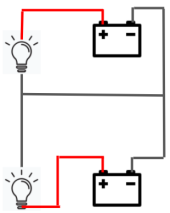I have a travel trailer which uses FLA as the standard house system and the return path of that system is through the trailer chassis. I also have an independent lithium solar system with the return path directly back to the battery. The two are only connected in that I have a DC2DC charger from the solar system to the house system.
I am now thinking about grounding the solar system by running ground wires from the equipment (inverter, etc.) to negative bus and then to chassis as well as a ground wire from the panels to the chassis.
What I don't understand is whether bonding the system and panels to the chassis for fault protection has any unintended consequences when that chassis is also the return path for the house system. For example, what happens if there is a fault in the solar system and over current is routed to the chassis...does that go into the house batteries?
(also, anyone have recommendations for a ground lug for the panels which are attached to superstrut using z brackets? The things I find on amazon assume a different rail system and superstrut fittings don't assume panels.)
Thanks
I am now thinking about grounding the solar system by running ground wires from the equipment (inverter, etc.) to negative bus and then to chassis as well as a ground wire from the panels to the chassis.
What I don't understand is whether bonding the system and panels to the chassis for fault protection has any unintended consequences when that chassis is also the return path for the house system. For example, what happens if there is a fault in the solar system and over current is routed to the chassis...does that go into the house batteries?
(also, anyone have recommendations for a ground lug for the panels which are attached to superstrut using z brackets? The things I find on amazon assume a different rail system and superstrut fittings don't assume panels.)
Thanks



